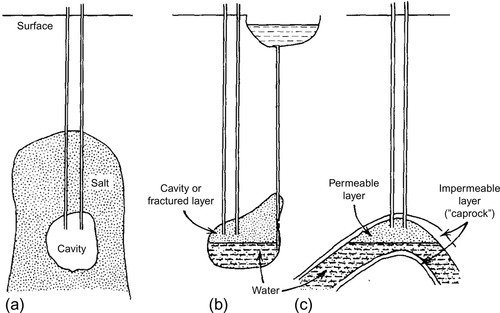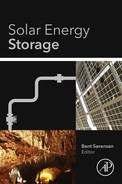Introduction and Overview
Bent Sørensen Department of Environmental, Social and Spatial Change, Roskilde University, Roskilde, Denmark
For some five decades, the cost of solar photovoltaic systems has declined from space industry levels toward affordability for individual consumers, helped by the occasional government subsidy programs in effect in one country or another for a limited time. The current decade is seeing solar panel prices being increasingly accepted by customers without subsidies; consequently, a rapid augmentation of installed capacity has taken place (IEA, 2014). A similar but less dramatic development has happened for solar thermal systems, having become common first as hot water providers, and now also for space heating in the intermediate latitude regions that need winter space heating but are still close enough to the equator to have a decent number of sunshine hours in winter. These developments make it timely to think of the obstacles for solar energy techniques to eventually become a major component in our energy systems. Among these problems, intermittency seems to be the most important. Either solar energy should be combined with other energy sources capable of complementing supply during dark hours, or devices for storing and regenerating energy must be part of the solar energy system. The best solution is probably a combination of including energy sources with a different delivery profile, having energy storage available, and taking advantage of energy transmission and trade possibilities, as well as any load management options that would be acceptable to the energy users.
This book focuses on energy stores suitable for integration into solar energy systems for delivering electric or thermal power to the end users. The combination of all the methods hinted at above is the subject of another recent book on energy intermittency, being the first to chart the global intermittency problem and to look at all the options for a sustainable energy system based on several renewable energy sources, storage, trade, and demand management, including the possible synergies offered by combining the solutions for dealing with intermittency (Sørensen, 2014).
In looking specifically at energy storage, two distinct areas of application for solar energy can be discerned. One is that of storage systems aimed at handling the obvious day-to-night storage requirement, caused by human activities not being restricted to hours of high solar radiation input. The second area is the seasonal storage that will store energy generated in summer or adjacent periods for use in winter at mid or high latitudes. Electricity demand varies over the year, with differences between different types of societies, but it is still fairly evenly distributed over the year. This is at least true compared with the situation for solar space heating, where the demand is obviously inversely correlated with solar supply, as soon as one departs substantially from the equator. Between these two extremes are the intermittency problems caused by passage of weather systems, with clouds and other atmospheric obstacles to receiving solar radiation at the Earth's surface. If solar intermittency is to be handled by energy stores, the storage systems must comprise units operating on diurnal, weekly, and seasonal time scales.
Several of the energy stores currently developed and ready for use are directed at shorter periods of storage. The shortest storage periods, related to fluctuations of solar energy production over seconds or minutes, are usually unimportant for heating purposes; for electric power production, any grid-connected system with some kilometer spacing between solar panels will smooth out such small-scale fluctuations. For isolated systems, short-term fluctuations may be handled by adding capacitor stores or flywheels, but even in this case the importance is declining, because the present generation of electricity-using equipment is either not very sensitive to modest variations in voltage or frequency (if AC), or it has built-in short-term storage, usually in the form of supercapacitors.
Moving on to storage levels capable of handling the variations in solar energy production during the day, or the nighttime nonproduction, the relevant storage periods would be 12-18 h, considering that the reduced solar radiation away from noontime may not correlate with the variations in demand. Stores of interest for this length of drawing time (in most cases also with a prolonged store-filling time) include various types of batteries, compressed air underground stores, pumped hydro, as well as fuel containers, which in a renewable energy scenario would have to contain fuels that can be created from biomass or electricity (such as certain biofuels and hydrogen). A range of such stores will be described and evaluated in the following chapters.
Finally, for storage lasting more than a week (as needed during episodes of heavy cloud cover or extended rainy periods) and seasonal storage (needed at latitudes with a substantial difference between summer and winter levels of incoming solar radiation, and for heat also because of temperature-related variations in space-heating demands), there are fewer storage options available. Economic considerations rule out storage in containers as compressed air and probably also in batteries, due to the cost being proportional to the amount of energy stored. Pumped hydro will remain an option as long as the upper reservoir is large enough, and so will fuel storage if containers can be replaced by inexpensive underground cavity options. Such cavities can be found in abandoned oil or gas wells, or they can be formed in certain aquifers and geological salt deposits (Figure 1.1). Both aquifer bends offering sections suitable for displacing water by a gas and slowly washed out cavities in salt domes are in substantial use today for natural gas storage, such as the strategic stores common in some European countries, holding 4-6 months of gas demand as a buffer against disruptions caused by major rupture of undersea gas supply pipelines or by political delivery blockades (Russian gas).

In connection with solar power and other sources of power generated by variable renewable energy flows, the relevant gas to store would be hydrogen. This is independent of the fate of the current efforts to develop hydrogen fuel cells for the automotive sector, because the solar-produced hydrogen stored could be used to regenerate electricity by conventional gas turbines, a low-cost technology available today. By the way, one should remember that fuel cells and electrolyzers are the same thing: all fuel cells can be used in reversed mode to generate hydrogen from electricity. Currently, common high-efficiency electrolyzers are alkaline fuel cells, but also the proton-exchange membrane fuel cells relevant for the transportation sector or the solid-oxide fuel cells aimed at electric power sector applications may be operated in reverse mode as electrolyzers (electricity to hydrogen) (Sørensen, 2011).
The underground hydrogen stores seeming to offer the most viable solution for longer time storage of solar electricity are often missing from the scientific literature on stores for renewable energy systems, but have in recent years taken the foreground in national and regional planning studies both in the United States (Lord et al., 2011) and in the European Union (Simón et al., 2014). Here, they are dealt with in the chapter on environmental issues.
As regards thermal energy storage, the most common technology is heat capacity storage using water, either in connection with individual building solar installations or in a central location for district heating based on solar collector arrays. Alternatives using gravel or other materials have been tested, as have phase change materials, but without pointing to any clear winners. In many locations, the best option for covering winter space loads in the absence of sufficient solar energy collection is to use renewable electricity or electricity from stores through heat pumps (Sørensen, 2014). A selection of such systems is discussed in the chapters below.
